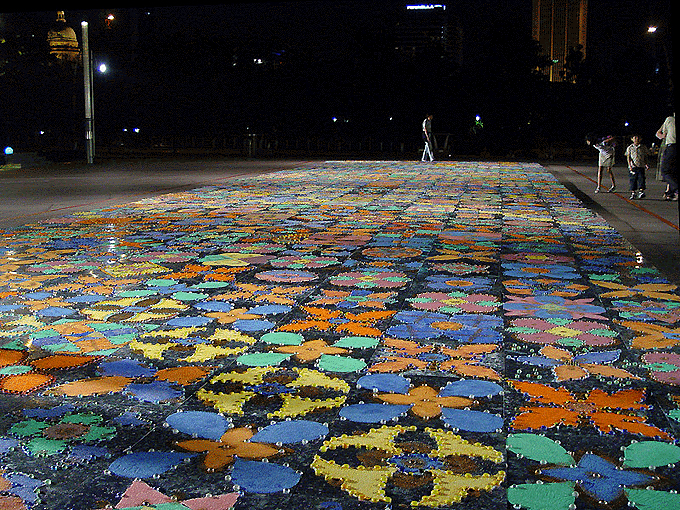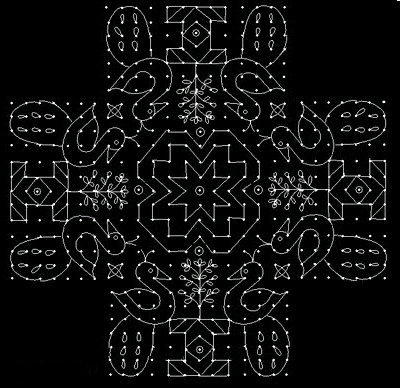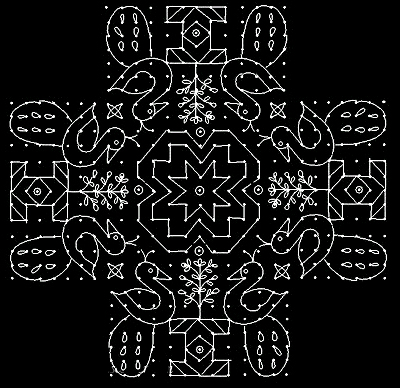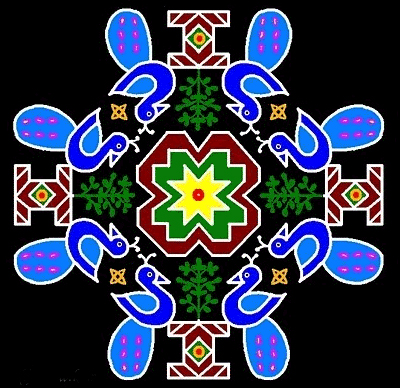
|
|
|
|
BY: SUN STAFF

Feb 18, 2011 — CANADA (SUN) — A study of the historical, spiritual and cultural elements of Vedic design. In previous segments we have mentioned the role Rangoli and Kolam arts play in Vedic households, in both ancient and modern times. This was also true during Lord Chaitanya's lila, when rangoli was a featured element of Mahaprabhu's wedding, and was employed in His household. "Laksmi devi worked without any assistance to serve her Lord and master yet she was always in a cheerful mood. Seeing the wonderful qualities and pious nature of Laksmi Devi, Mother Saci's joy increased by each hour and each day. From early morning she would work alone at the household chores, setting the example of an ideal wife. In the temple room she decorated the floor with auspicious designs made from colored paste; she drew the different symbols of the Lord like the conch shell and chakra. She also arranged for the paraphernalia required for the Lord's worship like incense, flowers, lamp, water, etc. She worshipped Tulsa Devi and also saw to the needs of Mother Saci, serving her with great affection. The wonderful attributes of Laksmi devi's nature did not go unnoticed by Lord Gaurachandra; although He never commented on it, He was extremely satisfied with her."
After the departure of Laksmi Devi, Nimai Pandit was married to Visnupriya Devi. We find two passages in Chaitanya Bhagavat describing the use of rangoli to decorate the house for the wedding: "Adhivas, an important ceremony before the day of the marriage was held at an auspicious time amidst great joy and festivity. The area set aside for the actual marriage ceremony was decorated with colorful hangings around the sides and across the tops. Water pots with intricate designs, ghee lamps, grains, yogurt, and strings of young mango leaves were all around. Different auspicious ingredients required for such an occasion were placed on the floor which had been beautifully designed with colored rice paste. [ ] "Early the next morning the Lord went for his bath in the Ganga, and on returning he went directly to the temple to worship the Supreme Lord Visnu. Thereafter he sat with his close relations to offer obeisances to their forefathers for their satisfaction. The festive mood was maintained by the musicians, dancers and singers performing loudly enough for everyone to hear. Every corner of the house was decorated, there were beautiful designs on the floor, water pots, grains, yogurt, lamps and strings of auspicious mango leaves hung everywhere. Colored festoons fluttered like flags in the wind, and the air was filled with festive excitement."
The worship of Laksmi Devi is central to the practice of creating rangoli. This is seen in the rangoli decorations typically drawn around Tulsi Devi's pot. In a grid of five onto five dots, the feet of Laksmi are drawn, and these are overlapped with the feet of Vishnu. A protective border is drawn around them. Laksmi's feet are also drawn in rangoli for Diwali festival, signifying the prayer for a visit from Her to one's home. Colors of red (for Laksmi) and yellow (for the Sun) are typically used. These rangoli and kolam designs are considered to be soundarya-laksmi, and stepping upon them is therefore considered disrespectful. Those of us not familiar with the art of rangoli can easily grasp the concept of making a picture on the ground, with anything from colored powder to sand or flower petals. The kolam patterns can be somewhat more difficult to comprehend making, because of their geometric complexity. Before we get into a study of some of the variations in rangoli and kolam motifs in different regions of India, let's first look at a simple example of how a kolam pattern is executed. One who is artistically inclined can weave intricate patterns with their fingers, but the easiest way to generate an accurate patterned image is to begin by drawing a grid of dots, then connecting them with lines that touch, interweave and border the dots. Following is an example of the four stages of building a kolam design. This one has the sun at the center, and geometrically placed peacocks and Tulsi circling around.

The grid begins with a simple cross comprised of 13 horizontal dots: 13 across, then 27 across, then 13 across. In other words, there are 7 lines with just 7 dots at the end of each cross-member. This is known as neer puli kolam.

The dots are then connected, as shown, to form the design motifs of Tulsi, peacocks, and star-like bhutti ornaments separating the peacocks.

Next, all the lines in the design are made heavier and the remaining dots are erased.

Finally, the designs are filled-in with colored powder to complete the kolam.
| |